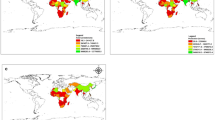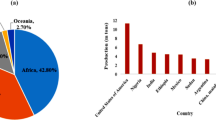Abstract
Sorghum bicolor (L) is classified globally as the fifth most important cereal crop after wheat, maize, rice, and barley. The demand for sorghum in Kenya is increasingly at 275,000 T per annum against the estimated production value of 150,000 T, providing income to more than 3 million people. Apart from food, Kenya Breweries Limited consistently provides a ready market to a huge amount of sorghum estimated at 60,000 tonnes annually and is expected to rise with time. In Kenya, the sorghum productivity level is at 0.7 t/ha in Arid and Semi-arid Lands areas (ASALs), which is far much below the potential yield ranging between 2 and 5 ton/ha. Sorghum’s rich diversity in ASAL areas makes it suitable for adaptability to Climate Smart Agriculture, Technologies Innovations Management Practices. This makes it a worthy crop for supporting livelihoods under the harsh climatic condition caused by climate change. In Kenya, Sorghum crop is usually cultivated at 0–2200 m above sea level in Eastern, Nyanza, and Coastal regions. Being a C4 plant, it has an efficient carbon dioxide fixation that makes it perform well in lower altitude areas with high temperatures, low, intermittent, and unreliable rainfall. Farmers in such areas opt to grow local varieties instead of the high-yielding hybrids due to poverty, inability to afford irrigation facilities, and essential necessities for production. Drought and water stress caused by inadequate and unevenly distributed rainfall in ASALs limit sorghum productivity. Also, pests, diseases, low yields, weeds, local planting seeds, and use of fertilizers are other challenges. On the other hand, enhancement of drought tolerance in arid climatic conditions involves mechanisms that maintain plant water status upon which genes and proteins are activated. This process most likely can affect plants resulting in a good number of physiological and biochemical changes that are crucial for growth and survival. Among them, changes in grain weight and protein content may affect the malt quality. As a defense mechanism in response to drought, sorghum landraces native to ASALs are likely to activate and involve participation of numerous proteins that may affect the grain and malt quality. It is imperative to come up with a drought-tolerant sorghum variety with good grain and malt quality and new technologies to be recommended to the stakeholders for improved sorghum production.
Access this chapter
Tax calculation will be finalised at checkout
Purchases are for personal use only
Similar content being viewed by others
References
Adalsteinsson, S. (1994). Compensatory root growth in winter wheat: effects of copper exposure on root geometry and nutrient distribution. J. Plant Nutrition. 17, 1501–1512.
Adiku, S.G., MacCarthy, D.S., Hathie, I., DiancoumbaM, Freduah B.S., Amikuzuno, J.,Traore, P.S., Traore, S., Koomson, E. and Agali, A. (2015). Climate Change Impacts on West African Agriculture: an Integrated Regional Assessment (CIWARA) Handbook of Climate Change and Agroecosystems: the Agricultural Model Inter comparison and Improvement Project Integrated Crop and Economic Assessments. Imperial College Press, London, pp. 25–73.
Anjum, S.A., Xie, X., Wang, L., Saleem, M.F., Man, C. and Lei, W. (2011). Morphological, physiological and biochemical responses of plants to drought stress. African Journal of Agricultural Research Vol. 6(9):2026–2032.
Awika, J.M. and Rooney, L.W. (2004). Sorghum Phytochemicals and their Potential impact on human health. Phytochemistry. 65, 1199–1221.
Batista, P.S.C., Carvalho, A.J., Portugal, A.F., E.A. Bastos, Cardoso, M.J., Torres, L.G., Mingote, Júlio M.P. and de Menezes, C.B. 2019. Selection of sorghum for drought tolerance in a semiarid environment Genetics and molecular research: 18(1).
Bekele, A., Bultosa, G., & Belete, K. (2012). The effect of germination time on malt quality of six sorghum (Sorghum bicolor) varieties grown at Melkassa, Ethiopia. Journal of the Institute of Brewing, 118(1), 76–81.
Beta, T., Rooney, L.W., Marovatsanga, L.T. and Taylor, J.R.N. (2000). Effect of chemical treatments on polyphenols and malt quality in sorghum. Journal of Cereal Science, 31, 295–32.
Bray, E.A., Bailey-Serres, J. and Weretlinyk, E. (2000). Responses to Abiotic Stresses. In: Buchanab, B.B., Gruisem, W. and Jones, R. (Eds.). Biochemistry and Molecular Biology of Plants. America Society of Plant Physiologists. Rockville, MD, USA. Pp. 1158–1203.
Calzada, R. T., Avila, J.G.A. and Gonzalez, F. G. 2019. Native Plants to Arid Areas; A Genetic Reservoir for Drought–Tolerant Crops.
Cicek, N. and Cakirlar, H. (2002). The effect of salinity on some physiological parameters in two maize cultivars. Journal of plant physiology 28(1–2), 66–74
Devnarain, N., Crampton, B. G., Chikwamba, R., Becker, J.V.W. and O’Kennedy, M.M. (2016). Physiological Responses of Selected African Sorghum Landraces to Progressive Water Stress and Re-watering. South African Journal of Botany. 103. 61–69
Dicko, M. H., Gruppen, H., Traoré, A. S., Voragen, A. G. and Van Berkel, W. J. (2006). Sorghum grain as human food in Africa: relevance of content of starch and amylase activities. African journal of biotechnology, 5(5), 384–395.
Embashu, W. and Nantanga, K. K. M. (2019). Malts: Quality and phenolic content of pearl millet and sorghum varieties for brewing nonalcoholic beverages and opaque beers Cereal Chemistry, Volume 96.
Farmer, E.E. and Mueller, M.J. (2013). ROS mediated lipid peroxidation and RES-activated signaling. Annual Review of Plant Biology. 2013;64:429–450
FAO. (2019). Index Mundi Statistics. USDA sorghum statistics.
Glantz, M.H. (1987). Drought and Economic Development in sub-Saharan Africa. In: Glantz, M.H. (Ed). Drought and Hunger in Africa: Denying famine a future. Cambridge University Press UK, pp 37–57.
Gong, H., Zhu, X., Chen, K., Wang, S. and Zhang, C. (2005). Silicon alleviates oxidative damage of wheat plants in pots under drought. Plant Science, 169: 313–321.
Gebretsadik, R., Shimelis, H. A., Laing, M. D., Tongoona, P. and Mandefro, N. (2014). A diagnostic appraisal of the sorghum farming system and breeding priorities in Striga infested agro-ecologies of Ethiopia. Agricultural Systems, 123, 54–61.
Izanloo, A., Condon, A.G., Langridge, P., Tester, M., Schnurbusch, T. (2008). Different mechanisms of adaptation to cyclic water stress in two South Australian bread wheat cultivars. Journal of Experimental Botany 59, 3327–3346.
Jaetzold, R., Schmidt, H., Hornetz, B. and Shisanya, C. (2006). Farm Management Handbook oo Kenya, Vol. II/CI. Ministry of Agriculture, Kenya and German Agency Technical Cooperation team (CTZ).
Kebede, H., Subudhi, P.K., Rosenow, D.T. and Nguyen, H.T. (2001). Quantitative trait loci influencing drought tolerance in grain sorghum (Sorghum bicolor L. Moench). Theoretical and Applied Genetics 103, 266–276.
Kenya Agricultural Value Chain Enterprises (KAVES). (2013). USAID – Kaves Value Chain Analyses, (June, 2013)
Khaton, M.A., Sagar, A., Tajkia, J. E., Islam, M.S., Mahmud, M.S. and Hossain, A.K.M.Z. (2016). Effect of moisture stress on morphological and yield attributes of four sorghum varieties. Progressive Agriculture 27(3): 265–271. ISSN: 1017-8139
Leichenko, R.M. and O’Brien, K.L. (2002). The Dynamics of Rural Vulnerability to Global Change: The Case of Southern Africa. Mitigation and Adaptation Strategies for Global Change 7. 1–18.
McDowell, N.G. (2011). Mechanisms linking drought, hydraulics, carbon metabolism and vegetation mortality. Plant Physiology. 2011; 155(3):1051–1059
McKersie, B.D. and Leshem, W.W. (1994). Stress and stress coping in cultivated plants. Kluwer Academic Publishers, Dordrecht, Netherlands.
Ministry of Agriculture Livestock and Fisheries. (2014). Annual Report.
Ministry of Agriculture Livestock and Fisheries. (2015). Economic Review of Agriculture 2015.
Munda, C. W., Secchi, S., Akamani, K.and Wang, G. (2019). A Regional Comparison of Factors Affecting Global Sorghum Production: The Case of North America, Asia and Africa’s Sahel Sustainability 11, 2135.
Munyiri, S. W., Pathak, R. S., Tabu, I. M. and Gemenet, D. C. (2010). Effects of moisture stress at flowering on phenotypic characters of selected local maize landraces in Kenya. Journal of Animal and Plant Sciences, 8 (1): 892– 899.
Muui, C. W., Muasya, R. M. and Kirubi, D. T. (2013). Baseline survey on factors affecting sorghum production and use in Eastern Kenya. African journal of food agriculture nutrition and development: ISSN 1684 5374Vol 13 No.1, 7339–7341
Muui, C. W., Muasya, R. M. Ngululu, S.,Kambura, A.,,Kathuli, P. Mweu, B. and Odhiambo D.O (2019). Sorghum Landraces Production in Nyanza, Coast and Eastern Regions, Kenya. Journal of Economics and Sustainable Development::ISSN 2222–2855(online) DOI: 10.7176/JESD Vol 10, No.10, 2019
Njagi, T., Onyango, K., Kirimi, L. and Makau J. (2019). Sorghum Production in Kenya: Farm-level Characteristics, Constraints and Opportunities. Technical Report, Tegemeo Institute of Agricultural Policy and Development, Egerton University, Kenya
Owuama, C. I. (1999). Brewing beer with sorghum, J. Inst. Brew. 105, 23–3
Paterson, A. H. (2008). Genomics of sorghum. International Journal of Plant Genomics. Article 362451.
Power, R., Güldemann, C., Crowther, A. and Boivin, N. (2019). Asian Crop Dispersal in Africa and Late Holocene HumanAdaptation to Tropical Environments. Journal of World Prehistory 32:353–392.
Ratnavathi, C.V., Patil, J.V. and Chavan U.D. (2016). Sorghum Biochemistry an Industrial Perspective. Science Direct: Sorghum Biochemistry: pp 63:105
Riziki, M. and Maina, M. (2013). The potential role of sorghum in enhancing food security in semi-arid eastern Kenya Journal of Applied Biosciences 71:5786– 5799
Shao, H.B., Chu, L.Y., Jalieel, C.A. Manivannan, P. Panneerselvam, R. and Shao, M.A. (2009). Understanding Water Deficit Stress-induced Changes in the Basic Metabolism of Higher Plants Biotechnologically and Sustainably Improving Agriculture and Ecoenvironmentin Arid Regions of the Globe. Crtl Rev Biotechnol. 29: 131–151.
Shashidar, R., Saroj, S.D. Harjare, S., Dhokane, V., Sharma, A. and Bandekar, J.R. (2000). Tropics. Inheritance of Flower Colour in Chickpea. J. Hered. 91:5
Takele, A. (2010). Analysis of rice profitability and marketing chain: The case of Fogera Woreda, South Gondar Zone, Amhara national regional state, Ethiopia (Doctoral dissertation, Haramaya University).
Taylor, J. R. N. (2003). Overview: Importance of sorghum in Africa Paper I, in Afripro Workshop on the Proteins of Sorghum and Millet: Enhancing Nutritional and Functional Properties for Africa (P. S. Belton and J. R. N Taylor, Eds). Available from: http://www.afripro.org.uk/papers/paper01Taylor.
Taylor, J.R.N., Schober, T.J., and Bean, S.R. (2006). Novel food and non-food uses of sorghum and millets. Journal of Cereal Science, 44, 252–271.
Tekele, A. (2010). Differential responses of electrolyte leakage and pigment compositions in maize and sorghum after exposure to and recovery from pre- and lost-flowering dehydration. Agricultural Sciences in China 9, 813–824.
Tegemeo Institute of Public Policy Analysis. (2018). Sorghum Production in Kenya. Survey report.
Timu, A.G., Mulwa, R., Okello, J., and Kamau, M. (2014). The role of varietal attributes on adoption of improved seed varieties: the case of sorghum in Kenya. Agriculture & Food Security, 3(1), 1–7.
Tuinstra, W.R., Grote E.M., Goldsbrough, P. B. and Ejeta, C. (1997). Genetic Analysis of Post-flowering Drought Tolerance and Components of Grain Development in Sorghum bicolor (L) Moench. Molecular Breeding 3, 439–448.
versus Beta-agonists, T. W. A. (2001). Effectiveness and safety of the oxytocin antagonist atosiban versus betaadrenergic agonists in the treatment of preterm labour. British Journal of Obstetrics and Gynaecology, 108(2), 133–142.
Wani, S.P., Abrizio R. and Wajia, N.R. (2012). Sorghum. In: Steduto P., Hasio, T.C., Ferenes, E. and Raes, D. (Eds.). Crop Yield Response to Water Stress. FAO Irrigation and Drainage Paper 66 pp 144–151
Wu, X., Cai, K., Zhang, G. and Zeng, F. (2017). Metabolite Profiling of Barley Grains Subjected to Water Stress: To Explain the Genotypic Difference in Drought – Induced Impacts on Malting Quality. Front Plant science 8:1547.
Author information
Authors and Affiliations
Editor information
Editors and Affiliations
Rights and permissions
Copyright information
© 2022 The Author(s), under exclusive license to Springer Nature Switzerland AG
About this chapter
Cite this chapter
Njinju, S.M., Gweyi, J.O., Mayoli, R.N. (2022). Drought-Resilient Climate Smart Sorghum Varieties for Food and Industrial Use in Marginal Frontier Areas of Kenya. In: Kumar, A., Kumar, P., Singh, S.S., Trisasongko, B.H., Rani, M. (eds) Agriculture, Livestock Production and Aquaculture. Springer, Cham. https://doi.org/10.1007/978-3-030-93262-6_3
Download citation
DOI: https://doi.org/10.1007/978-3-030-93262-6_3
Published:
Publisher Name: Springer, Cham
Print ISBN: 978-3-030-93261-9
Online ISBN: 978-3-030-93262-6
eBook Packages: Earth and Environmental ScienceEarth and Environmental Science (R0)




